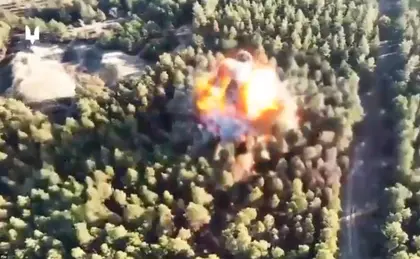A high-profile Kremlin military blogger confirmed weeks of Moscow attempts to destroy an embattled Kyiv bridgehead on the left bank of the Dnipro River failed because of unskilled Russian combat commanders and incompetent battle planning.
Ukrainian local air superiority above the Dnipro River village Krynky, a now-fortified village at the center of a bridgehead held mostly by elite Ukrainian Marine troops, and Moscow’s top commander's failure to deal with the problem, has left Russian troops vulnerable to 24/7 strike drone swarm and artillery, the Rybar Z Russian military information Telegram channel complained in a Jan. 9 general public post.
JOIN US ON TELEGRAM
Follow our coverage of the war on the @Kyivpost_official.
“We have all sorts of problems. In some cases, the situation is absolutely getting worse. The situation with air defenses in the Kherson region is in the category ‘cry on each other’s shoulders’,” Russia’s Rybar Z wrote.
“For the last six months on the level of a nation-state, we have been trying to solve the problem of repelling attacks by drone swarms, missiles and rocket artillery.
“In the Kherson region, there is equipment and resources (for the Russian military) to do this, but for some reason, their commitment isn’t possible because of various bureaucratic idiocies,” the comment in the usually adamantly pro-Kremlin channel said in part.
Rybar Z per open sources is a multiple-media platform operated by Denis Shchukin, a Moscow-based political strategist and information manager closely linked with Kremlin public messaging since the late 2010s.

Captured North Koreans Don’t Want Asylum in South Korea, Seoul Says
Since Russia’s February 2022 full-scale invasion of Ukraine, its information channels have routinely praised Russian President Vladimir Putin and the prowess of the Russian army, while denying Ukraine’s right to exist as an independent state and the Ukrainian military’s ability to fight effectively.
In a dramatic turnaround from its usually vicious anti-Kyiv narrative, the Rybar Z report said that Ukrainian drone operators are flying effectively unopposed by ineffective and poorly organized Russian air defenses, allowing Kyiv’s forces to observe practically any Russian heavy weapon moving in the vicinity, and even to stalk and attack individual Russian soldiers spotted out in the open.
🔥⚡️Another Russian thermobaric MLRS TOS-1A has been destroyed near Krynky left bank Kherson
— PS01 □ (@PStyle0ne1) January 9, 2024
As usual 💥💥💥 pic.twitter.com/hxEsWb3mxU
The report’s authors wrote that bureaucratic Russian military planning for counterstrikes is too slow, as a matter of policy allowing air attacks against Ukrainian positions or troops only after a general officer approves target lists briefed him in a PowerPoint presentation.
The Rybar Z report said: “On Jan. 6, sadly, we were witnesses of a (target planning) process during which five (Ukrainian) armored personnel carriers, seven self-propelled artillery pieces and two tanks were spotted on the right bank of the Dnipro River by (Russian) drones, but coordination for fire strikes dragged on for half a day, and then the information and the enemy himself just was dissipated, because the targets (spotted by the Russian drones) no longer were there.”
The channel also fingered failure by senior Russian commanders to deploy jamming equipment to battle the Ukrainian drone swarms above the Krynky bridgehead, and unimaginative low-level commanders unwilling or incapable of exercising local initiative, as problems well known by top army leadership yet unresolved for months.
“Our weakest point is still the human factor,” Rybar Z wrote. “You can jam the front lines with all kinds of weapons and systems as much as you want, (but) it is more difficult to deal with the rigid thinking of decision-makers.
“Until the minds of such officers come to the understanding and realization that working out fire support plans through a system of (PowerPoint) slides, and making decisions only after a few days do not apply to wartime, the situation (shortcomings) will be repeated time and time again,” the report warned.
An airborne infantry commander reportedly popular with front-line troops, Teplinskiy was appointed to command RJFS in October after his predecessor was sacked for allowing a surprise assault by Ukrainian Marines across the Dnipro in mid-October, and then instead of eliminating the Ukrainian infantrymen to dig in around the Krynky village.
Shchukin’s criticism of Russian military operational failures was one of the most detailed public confirmations to date, from Kremlin sources, of longstanding Ukrainian claims that positions held by elements of three Ukrainian Marine brigades totaling less than 500 men are holding well in strong defensive fortifications. Most Russian attempts to attack the Krynky bridgehead are broken up well before reaching Ukrainian entrenchments, those pro-Kyiv sources have said.
Robert Brovi, a drone operations commander coordinating supply and air attack units fighting in the Kherson sector, in a Jan. 6 blog said Russian attempts to approach the Ukrainian bridgehead had become so predictable, that pilots operating drones over the Dnipro’s left bank “are flying on daily safari… to hunt.”
Video of recent Ukrainian drone strikes posted by Brovi showed more than a dozen successful FPV drone strikes against Russian armored vehicles and troops including the demolition of multiple tanks and the spectacular detonation of a TOS-1 heavy flamethrower system touted by Russian state-controlled media as a terror weapon able to put troops opposing it to flight, by its fearsome reputation alone.
Krynky UPD ‼️
— PS01 □ (@PStyle0ne1) January 5, 2024
🇺🇦 General Staff: within 24 hours they repulsed six meat assaults by the Katsaps on the left.
An example of one of the latter is in the video.
Madyar: the remnants of the 810th are already refusing to storm Krynki, abandoning some new ones who are not familiar… pic.twitter.com/RKIJiNFsRg
The latest substantive attempt by Russian troops to attack the Ukrainian Marines, by Russia’s 810th Naval Infantry Brigade on Jan. 6, was decimated wholly by hobby drone attacks and Kremlin troops never got close enough to shoot their weapons against defenders, Brovi claimed.
A Jan 9 post attributed to a Russian officer serving in the Kherson sector, and published by the pro-Ukraine military information collator PSO1 on X, appeared to confirm Brovdi’s claim about the Jan. 6 engagement, saying in part: “(T)here are some idiots on our side (sorry for the swearing) who don’t learn from mistakes and drive equipment to Krynky. So, you understand, 90 percent of the equipment that gets there is not returned… The assault failed. We suffered losses in personnel and equipment, two tanks and three armored fighting vehicles were lost. You cannot assault when the enemy has superiority in artillery and drones!!! It is forbidden!!!”
Most pictured engagements were geo-located to roads to one to five kilometers south of Krynky village, Kyiv Post and open-source researchers found.
@GeoConfirmed
— Dominik (@99Dominik_) January 8, 2024
46.735904, 33.091962
Krynky, Kherson Oblast, Ukraine pic.twitter.com/7xtLHrQpPg
Russian military blogger Simon Pegov in a Jan.10 situation update acknowledged Ukrainian lines around Krynky were holding fast, calling Russian troops responsible for containing the bridgehead “exhausted.”
The Rybar Z report singled out the overall commander of Russia’s Joint Forces South (RJFS), Colonel General Mikhail Teplinskiy, as directly responsible for poor Russian army performance against the Krynky bridgehead.
Ukrainian Interior Ministry commentator Anton Gerashchenko in a Jan. 9 statement said that repeated Russian failures to eliminate the Kyrnky bridgehead may trigger an internal Kremlin battle to identify a scapegoat.
Col. Gen. Teplinksiy, due to his popularity with frontline fighting troops and Moscow’s unwillingness to acknowledge Ukrainian success in exposing Russia’s embarrassing hold on the Dnipro left bank, is too difficult to dislodge as the most likely fall guy, Gerashchenko suggested.
“Some sources claim that, for this purpose, a special group was created from among the officers of information counteraction of the Russian Armed Forces,” Gerashchenko said.
“They established a network of channels and groups on social media that create and distribute materials aimed at discrediting Teplinskiy... (he) has great ambitions, and he is unsuccessfully trying to eliminate our Ukrainian stronghold at any cost,” he said.
“That’s why the Russians are suffering huge losses in equipment and personnel, especially in airborne units. Of course, this hurts Teplinskiy’s reputation.”
You can also highlight the text and press Ctrl + Enter








